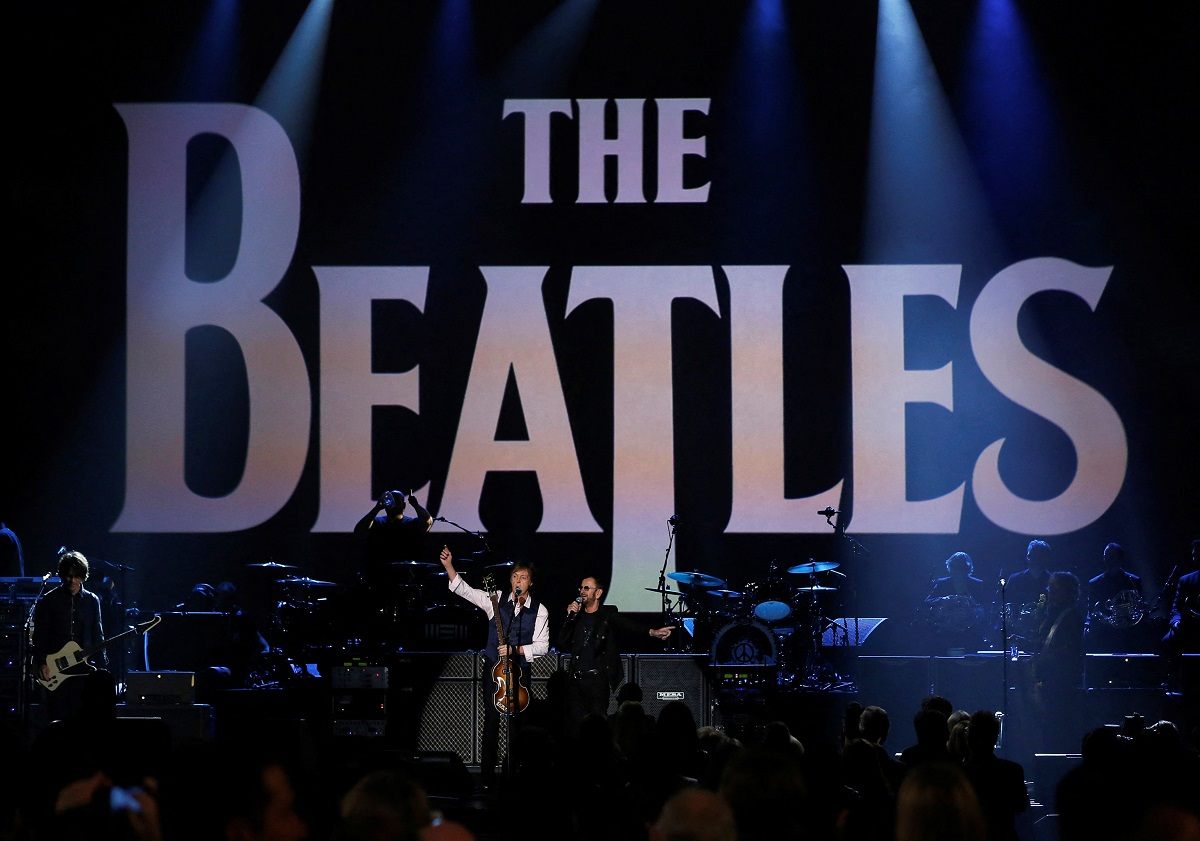
Paul McCartney (L) and Ringo Starr perform during the taping of “The Night That Changed America: A GRAMMY Salute To The Beatles”, which commemorates the 50th anniversary of The Beatles appearance on the Ed Sullivan Show, in Los Angeles January 27, 2014.
17:18 JST, November 12, 2023
One day in the late 1970s, John Lennon hit the record button on a boombox at his Upper West Side co-op and sang a new song he had been working on, accompanying himself on piano.
For decades, his Beatles songwriting partner Paul McCartney yearned to transform this raw solo demo into a studio-polished collaboration that could properly serve as the Fab Four’s final song. Finally, some 45 years later, the technology arrived that would free Lennon’s voice from its sonic trap of atmospheric hum and tinny piano so they could blend it seamlessly with his surviving bandmates’ fresh vocals and instruments.
And now I sit, a committed Beatles fan, listening to this “new” song for the 10th time on headphones in the dark at 4:13 a.m., willing myself to feel that special thing that would allow me to embrace it, to rave to you about its majestic beauty and poignant perfection.
But I can’t. “Now and Then” is just okay. And that’s not nearly good enough.
I have a few problems with “Now and Then,” which was released Thursday, and they revolve around sound and expectation. Let’s start with what we hear.
The song comes to us courtesy of the same miracle software program that director Peter Jackson deployed to astonishing effect in 2021’s “The Beatles: Get Back.” For that approximately 470-minute docuseries, Jackson’s engineering team managed to isolate the whispered conversations between John, Paul, George and Ringo from the din of their 1969 rehearsal sessions. But their software, known as MAL, can also create weird temptations.
For the 2022 reissue of the Beatles’ 1966 album “Revolver,” the software separated the original blend of tracks and allowed engineers to remix it. Maybe they created a more “sensible” stereo field or did a better job of showcasing certain instruments. But it felt like unbaking my favorite chocolate Bundt cake and reassembling it in a mixing bowl. Is that how we treat vital elements of the pop canon? As works to be deconstructed decades later, simply because we can?
(I contend that the best-sounding “Revolver” remains the U.K. vinyl version cut by Harry Moss in the 1970s. Sorry to geek out, but this is important stuff. It’s the Beatles.)
There is a certain poetic beauty to how “Now and Then” came about. Lennon’s widow, Yoko Ono – so often and so unfairly blamed for breaking up the Beatles – essentially reunited the band in 1994, when she handed over her late husband’s demo tapes. With the help of producer-of-the-moment Jeff Lynne, they worked up “Free as a Bird” into a poignant single for their 1990s “Anthology” project, complete with a heart-tugging video, as well as a somewhat less satisfying Lennon tune called “Real Love.”
But “Now and Then” seemed to be off-limits, sidelined by the limitations of Lennon’s original recording. There was a buzz on the tape. The voice and piano couldn’t be separated. George Harrison declared it “rubbish” before they gave up.
So the song sat, until Jackson’s MAL software came along to pristinely extract Lennon’s vocals from the buzz. McCartney and Ringo Starr got to work, adding new drum, bass, guitar and vocal tracks, as well as a McCartney piano contribution, said to match Lennon’s original playing, and guitar tracks that Harrison, who died in 2001, recorded back during their 1995 effort.
Now it’s being released with the blessing of the Lennon and Harrison estates. Which should settle the question of whether it has the right to exist.
And yet . . . I think about John as I listen to it. It is 1977 or 1979, and there he is, a still-ambitious and deeply competitive musician, full of love and conflict, unsure of his legacy or how he feels about it. Is he a rock star or a househusband? Is he retired, as he’d told everyone, or is he merely biding his time? A few years earlier, he was in a proper recording studio, working with the most famous musicians in the world, and now he was in this room at the Dakota, laying new songs onto a little cassette.
I do not begrudge McCartney and his desire to sing once again with his friends, to find some kind of closure. Even after all the volleys he took, some from Lennon himself, for supposedly being the lightweight in the partnership, he remained the generous elder statesman, forever protective and celebratory of his other half. If you see him in concert, nothing quite brings chills as when he stands there, acoustic guitar in hand, and plays “Here Today,” his 1982 tribute to Lennon, his 81-year-old voice bare and honest as it hits that falsetto.
This isn’t just a Record Store Day novelty pressed for collectors; this is the final creative collaboration of the most important rock band that ever existed. So listening once more on my headphones, with my deadline approaching, I wish I could somehow approximate how I felt when I heard “In My Life,” “I’ve Got a Feeling” or “We Can Work It Out.”
Is that too much to ask? Of course it is. McCartney and Starr owe us nothing at this point. Yet to just accept it at face value, to put a Beatles stamp on it and not think about that some 60-year legacy, feels almost disrespectful.
“Now and Then” is not terrible. It starts slow and picks up a little as the rhythm section kicks in. There is a minor-key melancholy in Lennon’s composition. But ultimately, it’s kind of mundane.
There is also the irreparably flawed nature of Lennon’s Dakota demos. They’re already familiar to any Beatles obsessive. Years ago, I paid $140 to some French guy for a five-CD bootleg that includes the original “Now and Then.” But they were captured on a boombox, and not even Jackson can change that.
Lennon’s voice is thin and sounds compressed and kind of froggy, which is a long way from how he liked to be captured in the studio. Just compare the Dakota demo of “Watching the Wheels” and the version that ended up on “Double Fantasy,” the 1980 record he made with Ono that served as his comeback and ultimately the final work of his lifetime. Lennon tended to multitrack his voice, thickening it up. I imagine that, if he had been around to record “Now and Then” properly, he’d have taken that same approach.
So “Now and Then” exists, and I’ve listened to it about enough, and because it is the Beatles, the bar is high, and expectations are higher. That “Now and Then” will now be included on the reissued “1967-1970,” otherwise known as “The Blue Album,” makes my point. A passable song is simply not good enough when you’re sharing vinyl with “Strawberry Fields Forever,” “A Day in the Life” or “Let It Be.”
Please listen to it. Form your own opinion. Then, when you’re done, put on “The Red Album” or “Blue” or any of the 13 studio records the Beatles made, and you’ll maybe get a tinge of what it feels like to be 7 years old with your dad’s KLH turntable pumping the most glorious music into the living room, perfect songs that simply can’t be matched.
"News Services" POPULAR ARTICLE
-

American Playwright Jeremy O. Harris Arrested in Japan on Alleged Drug Smuggling
-

Japan’s Nikkei Stock Average as JGB Yields, Yen Rise on Rate-Hike Bets
-

Japan’s Nikkei Stock Average Licks Wounds after Selloff Sparked by BOJ Hike Bets (UPDATE 1)
-

Japan’s Nikkei Stock Average Buoyed by Stable Yen; SoftBank’s Slide Caps Gains (UPDATE 1)
-

Japanese Bond Yields Zoom, Stocks Slide as Rate Hike Looms
JN ACCESS RANKING
-

Keidanren Chairman Yoshinobu Tsutsui Visits Kashiwazaki-Kariwa Nuclear Power Plant; Inspects New Emergency Safety System
-

Imports of Rare Earths from China Facing Delays, May Be Caused by Deterioration of Japan-China Relations
-

University of Tokyo Professor Discusses Japanese Economic Security in Interview Ahead of Forum
-

Tokyo Economic Security Forum to Hold Inaugural Meeting Amid Tense Global Environment
-

Japan Pulls out of Vietnam Nuclear Project, Complicating Hanoi’s Power Plans






















